
order for key signature symbol placement is not accidental, and follows a variation of the Circle of fifths music theory pattern called the Circle of fourths. Then the same for Eb in the second position, and so on for all the words in the phrase. So if the scale contains note Bb, this is always the first flat key signature symbol shown next to the treble or bass clef in the note B staff position(middle line).

įor a flat-based key signature (like this scale), the order is easily remembered using the following phrase, whose first letters indicate the note name to be flattened: The key signature symbols are always shown in the same order, no matter what the order of the actual notes on the staff. The key signature is set of sharps or flats (never mixed) shown after the treble or bass clef on the musical staff. If you want to leaner bout scales, they head over to our scales and chords blog posts.This step shows the order in which the symbols of a flat key signature must be placed next to the treble and bass clef. We are simply using these other scales within the piece.

If we did this, the piece is still said to be in A Minor, NOT A melodic minor, or A harmonic minor. We might add in extra notes to use the melodic or harmonic minor scales. For example we would create a piece in the key of A minor, so the key signature would have no sharps or flats. When using minor keys, it is important to remember that the key signature is for the natural minor. Many scales can be used within a piece in the key of G to give it a completely different sound. The musicians could use a blues scale or mode, such as the dorian mode. However the melody does not have to only use the G Major scale. If a piece of music uses chords with most of their notes from the G Major scale, then we can say that the piece is in the key of G Major. The key of piece of music is its melodic foundation.

Sometimes people use both words to mean the same thing but there is an important difference. What is the difference between a ‘key’ and a ‘scale’?


 0 kommentar(er)
0 kommentar(er)
